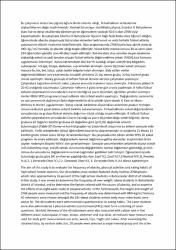Lise Çağı Kız Öğrencilerinde Obezite Sıklığı Fiziksel Aktivite Beslenme Alışkanlıklarının Değerlendirilmesi
Özet
Bu çalışmanın amacı lise çağı kız öğrencilerde obezite sıklığı, fiziksel aktivie ve beslenme alışkanlıklarının değerlendirilmesidir. Kesitsel tanımlayıcı özellikteki çalışma; İstanbul ili Bahçelievler ilçesi lise ve dengi okullarında öğrenim gören öğrencilerin yaklaşık %16'sı olan 2768 kişiyi kapsamaktadır. Bu çalışmada İstanbul ili Bahçelievler İlçesine bağlı fazla kilolu-obez öğrenci sıklığını, öğrencilerde obezite oluşumuyla ilişkisi olan etmenleri belirlemek ve sekiz haftalık fiziksel aktivite çalışmasının etkisini incelemek hedeflenmiştir. Alan araştırmasında 2768 kişinin boy-ağırlık alınarak VKİ= kg / m2 formülü ile obezite sıklığı tespit edilmiştir. Vücut kütle indeksi sonucu 30 ve üzeri çıkan 234 öğrenciden gönüllü olan 40 obez tespit edilmiştir. Katılımcılara otuz sorudan oluşan beslenme alışkanlığı anketi ve yedi sorudan oluşan fiziksel aktivite değerlendirme anketi (FADA),kısa formunu uygulamaları istenmiştir. Ayrıca katılımcıların deri kıvrım kalınlığı caliper aletiyle beş bölgeden; subscapular, triceps, biceps, abdomen, supraillactan alınmıştır. Çevre ölçümleri esnek olmayan mezura ile; kol, bel, kalça, uyluk, baldır bölgelerinden alınmıştır. Elde edilen veriler değerlendirildikten sonra katılımcılar tesadüfi yöntemle 20 kişi deney grubu, 20 kişi kontrol grubu olarak ayrılmıştır. Deney grubuyla 8 haftalık fiziksel aktivite aerobik çalışmaları yapılmıştır. Çalışmalara başlarken dinlenik nabız, çalışma sonunda maksimal nabız alınmıştır. Yüklenme şiddeti % 20-40 aralığında tutulmuştur. Çalışmalar haftanın 3 günü birer gün arayla yapılmıştır. 8 hafta fiziksel aktivite çalışmalarının sonunda deri kıvrım kalınlığı ve çevre ölçümleri, ağırlıkları yeniden alınmıştır. Veriler IBBM SPSS programına kayıt edilerek istatistiksel analizi yapılmıştır. Değişkenlerin parametrik ve non paremetrik dağılımları farklı değerlendirilerek İstatistiki işlem olarak Ki Kare ve Mann- Whitney U testleri uygulanmıştır. Sonuç olarak; beslenme alışkanlıkları anketinde grubun homojen olması nedeniyle genel olarak anlamlı farklılık bulunamamıştır. Fiziksel aktivite anketi değerlendirme sonuçlarında ise grubun fiziksel aktivite değerinin düşük olduğu tespit edilmiştir. 8 haftalık fiziksel aktivite çalışmalarının sonunda deri kıvrım kalınlığı ve çevre ölçümleri değerlendirildiğinde; deney grubuna ait değerler kontrol grubuna ait değerlere göre (p<0,05) değerinde anlamlı bulunmuştur.(Tablo-37) Deney ve kontrol grupları karşılaştırılarak araştırma da anlamlı sonuçlar elde edilmiştir. Farklı sebeplerden dolayı öğrencilerin bazılarına ulaşılamamıştır ve araştırma 15 deney 15 kontrol grubu olmak üzere 30 kişi ile tamamlanmıştır. Bu çalışmada elde edilen veriler SPSS 20 paket programı ile analiz edilmiştir. Değişkenlerin normal dağılımdan gelme durumları araştırılırken birim sayıları nedeniyle Shapiro Wilk's' den yararlanılmıştır. Sonuçlar yorumlanırken anlamlılık düzeyi olarak 0,05 kullanılmış olup; p<0,05 olması durumunda değişkenlerin normal dağılımdan gelmediği, p>0,05 olması durumunda ise değişkenlerin normal dağılımdan geldikleri belirtilmiştir. Öğrencilerin içinde bulunduğu gruba göre BKİ sınıflaması yapıldığında; Aşırı Zayıf %2, Zayıf %17,6 Normal %57,8, Preobez %14,2, 1.Derecede Obez %7,0 2. Derecede Obez %1, 3. Derecede Obez % 0,4 olarak saptanmıştır. The aim of this study is to evaluate the frequency of obesity, physical activities and eating habits of high school female students. Our descriptive,cross-section featured study involves 2768 people, which rates approximately 16 percent of the high school students in Bahcelievler district of Istanbul. In this study, it was aimed to determine the frequency of over weight- obese students in Bahcelievler district of Istanbul, and to determine the factors related with the causes of obesity, and to examine the effects of an eight week study of physical activity. In the field research, the height and weight of 2768 people were measured and the frequency of obesity was determined with BMI=kg/m2 formula. 40 volunteers were chosen amongst the 234 obese students whose body mass index levels were above 30. The 40 students were administered a questionnaire on eating habits. The same students were also administered a physical activity questionnaire(PAQ) short form consisting of seven questions. Skinfold thickness of the 40 volunteers were also measured with caliper tool in five different areas; subscapular, triceps, biceps, abdomen and suprailiac. An inelastic tape measure was used for body girth measurements on arms, waists, hips, thighs and calves. After examining the obtained data, by random selection, 20 people were selected as experimental group and the other 20 as control group. Eight weeks of physical activity and aerobic studies were carried out with the experimental group. Resting heart rates were calculated in the beginning of the study, and maximal heart rates were taken in the end of it. The effort intensity was adjusted to 20-40 % . The study was carried out on three days of the week, every other day. At the end of the workout of 8 weeks, the body girth measurements, skinfold thicknesses and weights were calculated again. The data was statically analyzed by recording on IBBM SPSS software program. The parametric and non-parametric distrubution variables were evaluated separately and, Ki Kare and Mann- Whitney U tests were applied in statistical process. As a result, there was no significant outcome in the evaluation of eating habits due to the homogenious distribution of the group of participants. In the evaluation of physical activity, the physical activity level of the group was determined as low. After the 8 week physical activity study, the skinfold thickness and body girth measurenments were evaluated and the findings of the experimental group were found significant (p<0,05) compared to those of the conrol group. (Table-37) The comparison of the results on experimental and control groups were found significant. Because of varied reasons of unavailability of some participants, the experiment was completed with 30 students; 15 people forming the experimental group and 15 people in the control group. The data obtained in this study was analyzed with SPSS 20 (Statistical Package for the Social Sciences) packaged software. When the normal distribution of variables were studied, Shapiro Wilk's was used because of the number of units. The significance level in this study was set to 0,05. The variables were not determined as normal distributed in p<0,05, whereas they were determined normal distributed in p>0,05. When a BMI classification of the students was carried out; 2% of them were determined as Too underweight, 17,6% as Undeweight, 57,8% as Normal, 14,2% as Pre-obese, 7,0% as Class 1 obese, 1% as Class 2 obese, and 0,4% as Class 3 obese.
Bağlantı
https://hdl.handle.net/11363/147Koleksiyonlar
- Yüksek Lisans Tezleri [164]

















